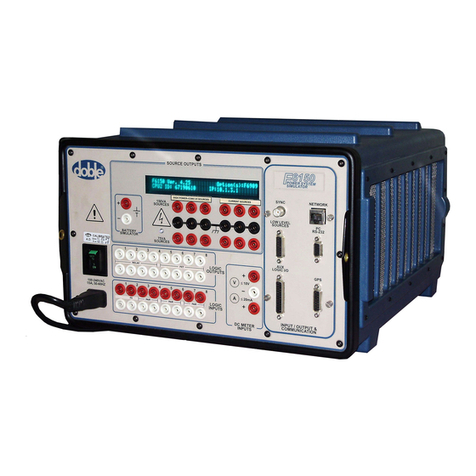
Warranty
72A-2543-01 Rev. F 12/2010 iii
Warranty
Equipment Limited Warranty
Doble warrants the products that it delivers to be free from defects in material and workmanship for a
period of one (1) year from the date shipped from the Doble facility. Equipment delivered under a
valid and duly executed Doble Service and Equipment Agreement will be replaced as set forth in said
agreement.
During the one-year warranty period, Doble will repair or replace, at its option, any defective products
or components thereof at no additional charge, provided that the product or component is returned,
shipping prepaid, to Doble. The Purchaser is responsible for insuring any product or component so
returned and assumes the risk of loss during shipment. All replaced products and components become
the property of Doble.
THIS LIMITED WARRANTY DOES NOT EXTEND TO ANY PRODUCTS WHICH HAVE
BEEN DAMAGED AS A RESULT OF ACCIDENT, MISUSE, ABUSE, OR AS A RESULT OF
MODIFICATION BY ANYONE OTHER THAN DOBLE OR AN AUTHORIZED DOBLE
REPRESENTATIVE.
EXCEPT AS EXPRESSLY SET FORTH ABOVE, NO OTHER WARRANTIES, EXPRESSED
OR IMPLIED, ARE MADE WITH RESPECT TO THE PRODUCT INCLUDING, BUT NOT
LIMITED TO, ANY IMPLIED WARRANTIES OF MERCHANTABILITY AND FITNESS
FOR A PARTICULAR PURPOSE. DOBLE EXPRESSLY DISCLAIMS ALL WARRANTIES
NOT STATED HEREIN. IN THE EVENT THE PRODUCT IS NOT FREE FROM DEFECTS
AS WARRANTED ABOVE, THE PURCHASER'S SOLE REMEDY SHALL BE REPAIR OR
REPLACEMENT AS PROVIDED ABOVE. UNDER NO CIRCUMSTANCES WILL DOBLE
BE LIABLE TO THE PURCHASER OR ANY USER FOR ANY DAMAGES, INCLUDING
WITHOUT LIMITATION, PERSONAL INJURY OR PROPERTY DAMAGE CAUSED BY
THE PRODUCT, ANY INCIDENTAL OR CONSEQUENTIAL DAMAGES, EXPENSES, LOST
PROFITS, LOST SAVINGS, OR OTHER DAMAGES ARISING OUT OF THE USE OF OR
INABILITY TO USE THIS PRODUCT.
Software Limited Warranty
Doble warrants that: (i) for a period of one hundred twenty (120) days from the date of shipment from
Doble, the media on which the Software is furnished will be free of defects in materials and
workmanship under normal use; and (ii) for a period of one year from the date of shipment from Doble,
the Software will perform in substantial conformance to its published specifications. This limited
warranty extends only to the original licensee. Licensee’s exclusive remedy and Doble’s entire liability
under this limited warranty will be, at Doble’s option, to repair or replace the Software, or to refund a
pro rata portion of the purchase price. Doble makes no warranty or representation that its software
products will meet Licensee’s requirements, that the operation of the software products will be
uninterrupted or error free, or that all defects in the software products will be corrected.
This warranty does not apply if the software (a) has been altered, except by Doble, (b) has not been
installed, operated, repaired, or maintained in accordance with instructions supplied by Doble, (c) has
been subjected to abnormal physical or electrical stress, misuse, negligence, or accident, or (d) is used
in ultra-hazardous activities.






























